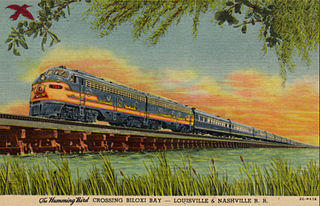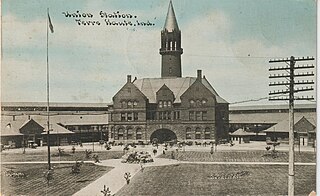The route
The train began on Pennsylvania Railroad territory from Chicago to Cincinnati as train 200 southbound (and train 201 northbound); the Louisville and Nashville Railroad operated the Southland as train 33 (and train 32 northbound) from Cincinnati to eastern Kentucky, eastern Tennessee and then to Atlanta. [3] Wabash Railroad trains carried passengers from Detroit to Fort Wayne, where passengers would switch to a Grand Rapids to Richmond, Indiana PRR train segment of the Pennsylvania Railroad train heading to Cincinnati and Florida. [4] By the mid-1950s the Baltimore & Ohio replaced the Wabash for the Detroit-to-Cincinnati segment made the connection (#57 south, and #58 north), with through sleepers to St. Petersburg. [5] [6]
It travelled along Central of Georgia Railway territory from Atlanta's Atlanta Union Station to Macon's Terminal Station and Albany, Georgia's Union Station. Originally, the train went southeast from this point to Jacksonville, Florida. However, in a move that allowed the most direct route for trains through Atlanta to reach the western part of the Florida peninsula and the west coast, in 1928 the Southland operators moved the train over to the newly completed Perry Cutoff. [7] The Atlantic Coast Line picked up the route from Albany to Thomasville, and then along the Perry Cutoff through western Florida. [8]
Western routes
South of Macon ran the main western route, to Americus and Albany, Camilla, Pelham, Thomasville; Monticello, FL, Perry, Cross City, Dunnellon, Inverness and Trilby. After Trilby the route split and there were two different western Florida destinations: train 33 (train 32 northbound) via Atlantic Coast Line tracks to Tarpon Springs, Dunedin, Clearwater, St. Petersburg; and train 37 (train 38 northbound) splitting off the route at Trilby to Tampa and then to Bradenton and Sarasota. [9] In later years, the south of Tampa segment would be replaced by a coordinated time departure bus for Bradenton, Sarasota and Fort Myers. [10] [11]

The Atlantic Coast Line Railroad was a United States Class I railroad formed in 1900, though predecessor railroads had used the ACL brand since 1871. In 1967 it merged with long-time rival Seaboard Air Line Railroad to form the Seaboard Coast Line Railroad. Much of the original ACL network has been part of CSX Transportation since 1986.

The Louisville and Nashville Railroad, commonly called the L&N, was a Class I railroad that operated freight and passenger services in the southeast United States.

The Cincinnatian was a named passenger train operated by the Baltimore and Ohio Railroad (B&O). The B&O inaugurated service on January 19, 1947, with service between Baltimore, Maryland and Cincinnati, Ohio, carrying the number 75 westbound and 76 eastbound, essentially a truncated route of the National Limited which operated between Jersey City, New Jersey and St. Louis.
Northern Arrow was one of the named passenger trains of the Pennsylvania Railroad, starting at Cincinnati, Ohio and ending at Mackinaw City, Michigan. It had merging branches originating from Chicago, Illinois, converging in Fort Wayne, Indiana, and a train from St. Louis, Missouri from the west, converging at Richmond, Indiana. Carrying the number #519 northbound and #520 southbound, it used the Grand Rapids and Indiana Railroad, a leased subsidiary of the Pennsylvania system.

Withlacoochee State Trail is a 46-mile (74 km) long paved, multi-use, non-motorized rail trail in Florida located in Citrus, Hernando and Pasco counties. It follows along the Withlacoochee River and passes through the Withlacoochee State Forest. It is the longest paved rail trail in Florida.

The Union Station built in 1930 in Atlanta was the smaller of two principal train stations in downtown, Terminal Station being the other. It was the third "union station" or "union depot", succeeding the 1853 station, burned in mid-November 1864 when Federal forces left Atlanta for the March to the Sea, and the 1871 station.

Mobile station was a train station in Mobile, Alabama. It was built in 1956 and demolished in 2007.

Gulfport station is a closed Amtrak intercity train station in Gulfport, Mississippi, United States. Gulfport is a former union station that served the Louisville and Nashville Railroad and Gulf and Ship Island Railroad.

The Royal Palm was a named train of the Southern Railway that ran from Cincinnati, Ohio, to Jacksonville, Florida, and then on the Florida East Coast Railway's East Coast Champion to Miami, Florida. The train was discontinued in 1970.

The Humming Bird was a named train of the Louisville and Nashville Railroad (L&N). The train, inaugurated in 1946, originally ran from Cincinnati, Ohio, to New Orleans, Louisiana, via Louisville, Nashville, Birmingham, Montgomery and Mobile and later via a connection at Bowling Green, Kentucky, to Memphis, Tennessee. A connection to Chicago was provided by the Chicago and Eastern Illinois Railroad.
The Cincinnati Limited was a named train of the Pennsylvania Railroad; the train traveled from New York City's Pennsylvania Station to the Cincinnati Union Terminal. It was a rival to New York Central's Ohio State Limited. The Cincinnati Limited carried connecting sleeping cars to the Louisville and Nashville Railroad's Cincinnati to New Orleans Pan American. By the mid-1950s, the sleeper extension on L&N lines ended at Memphis instead of New Orleans.
The South Wind was a named passenger train equipped and operated jointly by the Pennsylvania Railroad, the Louisville and Nashville Railroad, the Atlantic Coast Line Railroad, and the Florida East Coast Railway. The South Wind began operations in December 1940, providing streamliner service between Chicago, Illinois and Miami, Florida. This was one of three new seven-car, all-coach streamliners operating in coordination every third day along different routes between Chicago and Miami. The other two longest enduring Chicago-Florida trains were the City of Miami and the Dixie Flagler. The South Wind remained in service through the creation of Amtrak in 1971.
The Gulf Coast Limited was a passenger train operated by Amtrak in the southern United States. It ran daily from Mobile, Alabama, to New Orleans Union Passenger Terminal in New Orleans, Louisiana.
The Ponce de Leon was a named train of the Southern Railway which ran from Cincinnati, Ohio, to Jacksonville, Florida, from 1924 to the mid-1960s.

The Dixie Flyer was a premier named passenger train that operated from 1892 to 1965 via the "Dixie Route" from Chicago and St. Louis via Evansville, Nashville, and Atlanta to Florida. However, the train persisted to 1969 as an Atlanta to Florida operation, solely run by the Atlantic Coast Line Railroad and its successor. The Flyer's route varied in early years, but by about 1920 was set as follows:
The Flamingo was a passenger night train operated by the Louisville and Nashville Railroad.

The Kansas City–Florida Special was a pooled night train and the premier train of the Frisco Railroad and the Southern Railway. Operating from Kansas City, Missouri to Jacksonville, Florida, it was unique as being one of very few long distance passenger train to traverse the Mississippi River south of St. Louis, Missouri and north of New Orleans, Louisiana.
The Skyland Special was a long distance named night train of the Southern Railway from Asheville, North Carolina, to Jacksonville, Florida, USA. Apart from the Southern's trains originating in Cincinnati, the Skyland Special was distinctive as an all-Southern Railway operation going directly to Florida. It was also one of the few Southern Railway trains making a direct north-south route through South Carolina. In early years, the train had sections that continued to various destinations in Florida.
The Marietta depot is a former freight and passenger stop in Marietta, Georgia. It was originally built in 1864 for the Western and Atlantic Railroad, a railroad between Chattanooga, Tennessee and Atlanta, Georgia. That railroad was absorbed by the Nashville, Chattanooga and St. Louis Railway. In turn, the latter railroad was merged into the Louisville and Nashville Railroad in 1957.

Terre Haute Union Station was a passenger train station located at Ninth Street and Spruce Street, Terre Haute, Indiana, serving riders for nearly 67 years. It was completed on August 15, 1893, at the cost of $273,000.












